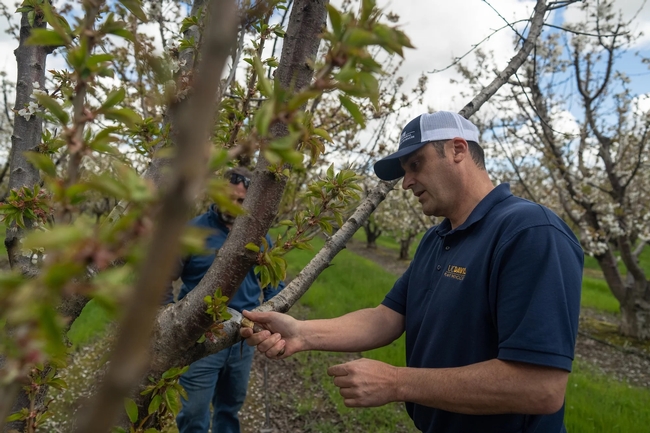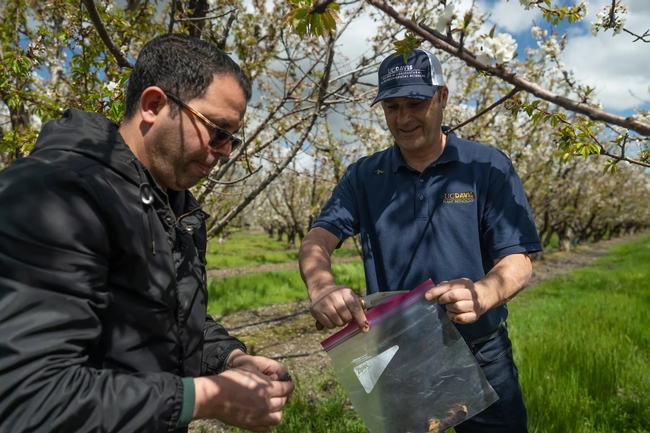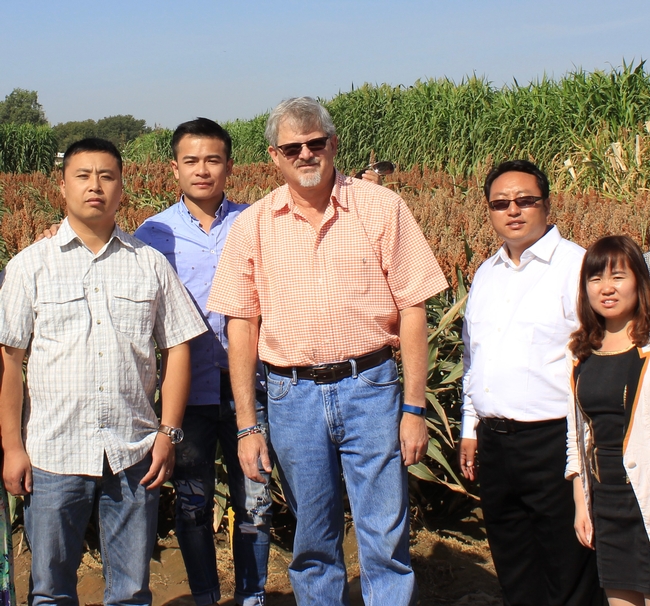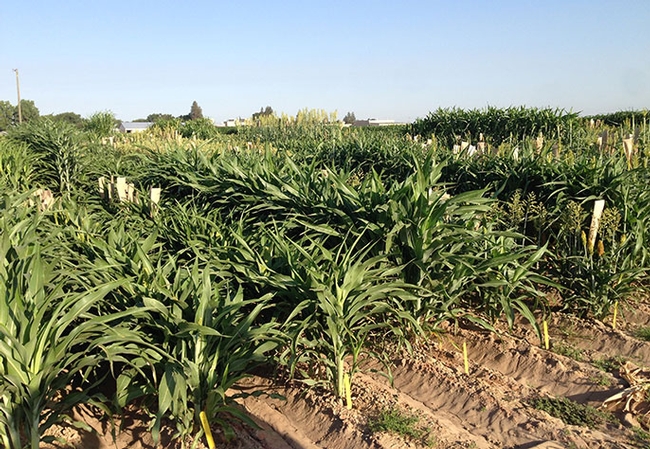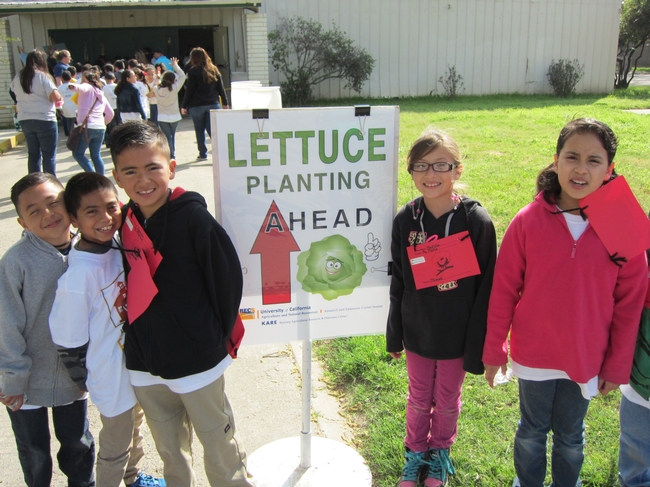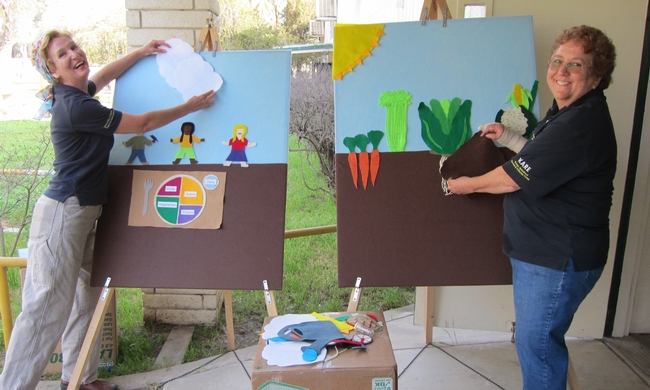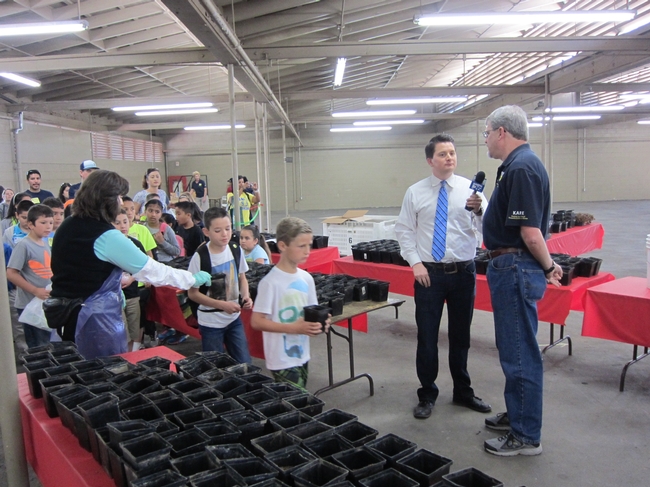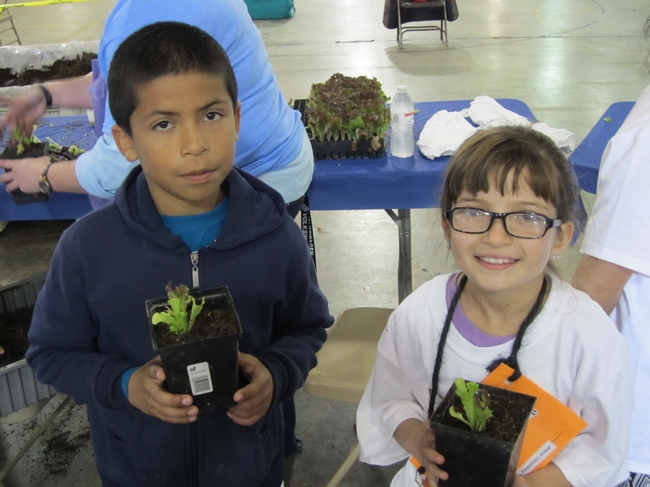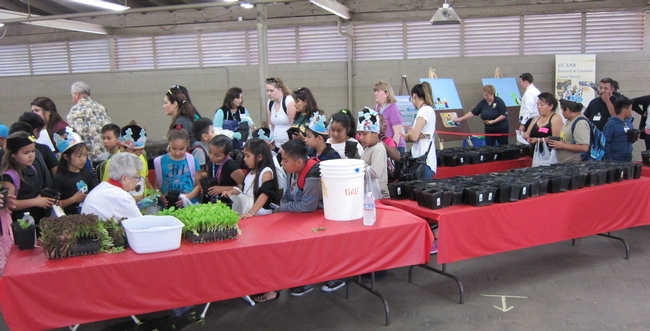
Posts Tagged: Kearney
Winter atmospheric rivers gave pathogens, diseases path to infect crops
Outbreaks similar to El Niño-influenced issues of the 1990s
The wave of atmospheric rivers that swept across the state this winter has created the right conditions for plant pathogens that haven't been seen for decades in California. University of California, Davis, plant pathologist Florent “Flo” Trouillas is getting more calls from growers and farm advisors concerned about potential crop damage.
“Generally, whenever you have rain events, you're going to have problems,” said Trouillas, a Cooperative Extension specialist who is based at the Kearney Agricultural Research and Extension Center in Parlier. “In wet years we get really busy because most pathogens need and like water.”
Trouillas is like a disease detective. He splits his time between the field and the lab, working to diagnose pathogens, diseases and other ailments that strike fruit and nut crops such as almonds, cherries, olives and pistachios.
On a recent visit to an almond orchard near Fresno, Trouillas joined Mae Culumber, a nut crops farm advisor for UC Cooperative Extension Fresno County. A few weeks earlier, the two had walked the orchard, taking note of the base of some trees that had gumming — a thick, jelly-looking substance indicating a pathogen had taken hold.
“A lot of what Florent is doing is trying to assess patterns on a landscape,” Culumber said. “Sometimes things may look like they are one thing, but it could be another problem.”
When the two returned weeks later, the amber-colored gumming had moved into the canopy, looking like gumballs stuck to branches, some of which were already dead. “It's getting out of control from before,” Trouillas says. “This branch was killed. This is widespread.”
From the field to the lab
Lab testing confirmed what Trouillas believed was the culprit: Phytophthora syringae, a pathogen that can affect almond crops but is rarely seen in California. If it is found, generally the site of infection are wounds caused by pruning, but that is not the case here, where the infection began in the canopy at twigs, or small branches.
It is a threat to a key crop, which according to the California Department of Food and Agriculture, generates $5 billion annually. The last time Phytophthora syringae hit California was in the 1990s after a series of El Niño-influenced storms. Trouillas, who has a photographic memory, remembered reading about it in an old manual.
“It's rare for California and one that we see mostly following atmospheric rivers,” he says.
“The disease will only happen following these extremely wet winters.”
Phytophthora is soilborne, mostly found in tree roots, and doesn't generally spread up into branches. But the intense storms created the right conditions for the pathogen to “swim” up trunks as winds blew spores into the air and rain dropped them back down into the canopy, Trouillas said.
Some of the trees in this orchard will die; others can be saved by pruning infected branches and applying a recommended fungicide, he said.
Identification, diagnosis, education
Trouillas is one of more than 50 Cooperative Extension specialists at UC Davis and each is charged with identifying problems and developing solutions for those issues in support of agriculture, the ecosystem and communities throughout the state.
In his role, Trouillas focuses not only on pathology and research but also on educating growers, nursery staff, pest control advisers and others in agriculture about ways to manage potential threats and how to prevent crop damage.
“His role is very crucial,” said Mohammad Yaghmour, an orchard systems advisor for UC Cooperative Extension Kern County. “He's not only on this mission to educate growers but he's also a source of education for us.”
Trouillas typically conducts one or two site visits a week, usually after a farm advisor reaches out about a problem they can't solve on their own.
“This allows us to be at the forefront of disease detections in California,” he said.
He likens these visits to house calls a doctor would make, only to fields instead. And one of those calls recently took him to a cherry orchard in Lodi.
“These guys help me quite a bit,” said Andrew Vignolo, a pest control adviser with Wilbur-Ellis who asked for a consult. “I bug them a lot.”
The visit starts like any consult in a doctor's office, only the questions come fast as they walk around the Lodi orchard where branches are dying, there is gumming and the trees appear stressed. Some look to be sunburned from exposure. Old pruning wounds show cankers, indicating that past disease treatments didn't get rid of whatever was affecting the trees.
Trouillas asks about the cultivar of the trees because some varieties are more susceptible to pests or diseases. He focuses on stress because that opens the door to disease.
Do they prune in the dormant winter months or in summer when pathogens are more prevalent? Does the soil get tested? How old are the trees? What about nutrition?
“I'm trying to figure out how they got infected so bad,” Trouillas said, walking the orchard. “Bacterial canker is a very mysterious disease.”
He thinks it might be a bacterial canker disease and shaves some bark to take to the lab for testing. He wants to come back next winter to take some samples to see where the pathogen is overwintering.
“We'll know in a few weeks if we have a fighting chance,” Vignolo said.
Be it Lodi, Fresno or elsewhere in the state, Trouillas focuses on local conditions. But what is learned in one field can be passed on to others, providing early warnings or advice for those in similar situations. “All these efforts at collaboration, from the field, to the lab, going through research projects, there's only one goal here — to help the farmers of California.”
Director of the UC Kearney Research and Extension Center retires

As a Peace Corps volunteer in Niger in the early 1980s, Dahlberg was intrigued by sorghum, a staple food being cultivated by the country's vast population of subsistence farmers.
“I was impressed with the fact that sorghum was so drought tolerant,” Dahlberg said. “Nigerien farmers relied solely on rain for their sorghum and millet crops.”
Upon returning to the U.S., he earned a master's degree at the University of Arizona and a Ph.D. at Texas A&M, where his research focused on sorghum. He worked with the USDA Agricultural Research Service in Puerto Rico for 7 years and then spent the next 10 years as research director with the National Sorghum Producers in Lubbock, Texas.
When Dahlberg took the helm of the 330-acre UC agricultural research center in 2010, he and colleagues at the UC West Side Research and Extension Center and at UC Davis began conducting sorghum forage variety trials. Sorghum wasn't new to California. In the past, it had mainly been used for animal feed. But Dahlberg believed the crop's adaptability – excellent for forage, biofuels and gluten-free human food – offered the grain a rosy future in the Golden State.
"With our research, we have provided California farmers who are thinking about growing sorghum access to locally generated, research-based information to help them make the decision," Dahlberg said.
In 2015, Dahlberg and UC Berkeley specialist Peggy Lemaux launched a sweeping drought research project at KARE. The five-year study, funded with a $12.3 million grant from the Department of Energy, researched the genetics of drought tolerance in sorghum and how soil microbial communities interacted with sorghum roots to battle drought stress.
A journal article published in Proceedings of the National Academy of Sciences in 2018 presented the first detailed look at the role of drought in restructuring the root microbiome. The plant switches some genes on and some genes off when it detects water scarcity and access to water.
“That has implications for feeding the world, particularly considering the changing climate and weather patterns,” Dahlberg said.
In recent years, Dahlberg helped reestablish tea research at Kearney, initiated nearly 60 years ago in a study funded by Thomas J. Lipton, Inc. At the time, Lipton was seeking to grow tea for the instant tea market. When the Kearney tea research program was scrapped in 1981, a researcher had a handful of the best tea clones planted in the landscape around buildings at Kearney.
Those shrubs became the basis for a new tea research trial planted at Kearney in 2017 with UC Davis professor Jackie Gervay Hague to determine whether drought stress impacts the production of phenolics and tannins in the tea.
“We know we can grow good tea here and we can grow high tonnage,” Dahlberg said. “We want to determine if we can do that on a consistent basis and whether we can improve tea quality through irrigation management.”
In retirement, Dahlberg plans to relocate to Lake Ann, Mich., to be close to family. UC Cooperative Extension irrigation specialist Khaled Bali will serve as interim director of the UC Kearney Agricultural Research and Extension Center.
UC research could help farmers face droughts worldwide
Sorghum is not only a potential drought-tolerant crop for the San Joaquin Valley, it also presents the opportunity for scientists to understand the mechanism behind drought tolerance at the genetic level, said UCCE sorghum specialist Jeff Dahlberg in a segment on ABC 30 Action News.
Reporter Cristina Davies spent an hour and a half at the UC Kearney Agricultural Research and Extension Center in Parlier during the sorghum harvest to learn about the potential of sorghum research.
"If we can elucidate the genetics behind (drought tolerance), what we believe is we can use those genetics to see if the genetics are available in corn, or in rice, or in wheat," Dahlberg said. "I think the genes may be there. We just don't have the tools yet to search for the genes in those crops."
Conducting drought-tolerance research in California is ideal because the summer is typically devoid of rain. Researchers can control exactly how much water is applied to each sorghum plot. The research has revealed more than 100 genetic markers that may confer drought tolerance.
"We've been really thrilled with the data that's been coming out of this. Like most research, we are learning so many things we don't understand," Dahlberg said.
The research is being conducted in collaboration with the USDA's Agricultural Research Service research center, which is across the street from Kearney. USDA research scientist Devin Coleman-Derr was present for the sorghum harvest.
"Like humans take probiotics, there may be a use for microbes in sort of promoting better and better yields in the field," Coleman-Derr said.
The 330-acre UC Kearney Agricultural Research and Extension Center is the University of California's largest off-campus agricultural research facility.
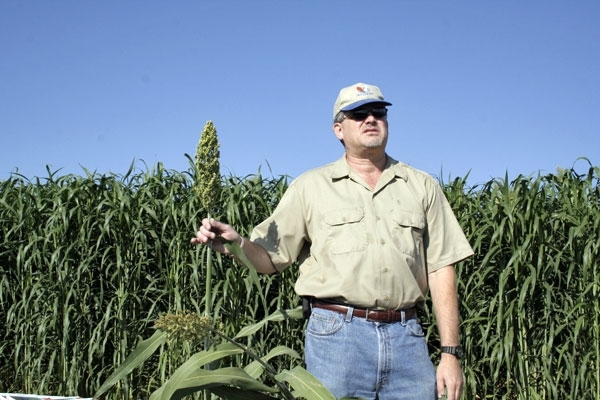
UCCE specialist Jeff Dahlberg studies sorghum at the UC Kearney Agricultural Research and Extension Center in Parlier.
Microbes associated with plant roots could be a key to helping plants survive drought
As sorghum plants cope with drought conditions, the plants' roots and adjoining microbial communities are communicating in a chemical language that appears to improve the plants' chances under water stress.
“It's amazing,” said Peggy Lemaux, UC Cooperative Extension specialist. “We know there are lots of microbes in the soil and, for the most part, ones in the surrounding soil stayed the same under drought conditions. We only saw changes in those microbes closely associated with the roots.”
The role of drought in restructuring the root microbiome was the first published discovery to come out of a sweeping drought research project underway since 2015 in the fields at UC Kearney Research and Extension Center in Parlier. The five-year study, funded with a $12.3 million grant from the Department of Energy, aims to tease out the genetics of drought tolerance in sorghum and its associated microbes. Using sorghum as a model, scientists hope the research will help them understand and improve drought tolerance in other crops as well.
The new research results from the lab of USDA's Devin Coleman-Derr at UC Berkeley, published April 16, 2018, in the Proceedings of the National Academy of Sciences, document the fate of microbes associated with sorghum roots under three distinct irrigation regimens. Because the San Joaquin Valley generally sees no rain during the growing season, it is the ideal place to mimic drought conditions by withholding irrigation water.
All plots received a pre-plant irrigation to initiate growth. In the control plots, sorghum was irrigated normally, with weekly watering through the season. In the plot simulating pre-flowering drought stress, the plants received no additional water until flowering, about halfway through the season. The third treatment was watered normally until it flowered, and then water was cut off for the rest of the season.
Beginning when the plants emerged, the scientists collected samples from each plot on the same day and time each week for 17 weeks. In a mini, in-field laboratory, roots, rhizosphere (zone surrounding the root), leaves and soil samples from 10 plants in each plot were immediately frozen and transported to Berkeley, where they were disseminated to collaborators, who investigated the plant and microbial responses at the molecular level.
“When a sorghum plant is subjected to drought, it starts sloughing off metabolites, nutrients and amino acids from the roots. The compounds appear to communicate to the neighboring microbial community that the plant is under stress,” Lemaux said. “That selects out a certain population of microbes. Certain types of microbes increase, others go away. When you add water back, the microbial community returns to its pre-drought population in just a few days.”
The researchers cultured two specific microbes that were enriched in the rootzone under drought conditions. They coated sorghum seeds with the microbes and planted them under drought conditions in a growth chamber. This treatment encouraged the plant to grow more roots.
“The microbes appear to improve plant growth during drought,” Lemaux said. “Those microbes appear to be helping plants survive drought. We didn't know that was happening before we got these results.”
Lemaux said the research might lead to future field use of the research breakthrough.
“A lot of companies are interested in the microbiome,” she said. “Some are already selling microbes to coat seeds.”
'Agriculture: Food for Life' is the theme of National Ag Week
How are you celebrating American agriculture in your life? In advance of National Ag Week, March 19-25, and National Ag Day, March 21, Central Valley third-grade students were “learning with lettuce” how to bring more agriculture into their lives last week. The UC Kearney Agricultural Research and Extension Center offers the free lettuce plantings every year at Farm and Nutrition Day in Fresno County and Kings County, typically around the time of National Ag Week.
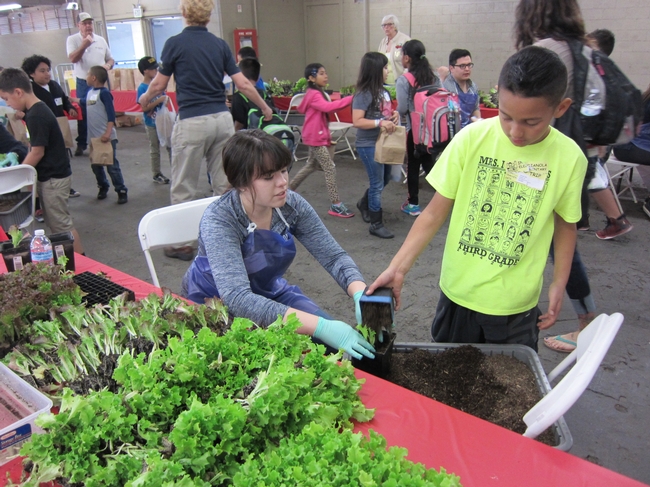
Students with the help of volunteers learned how to plant tiny lettuce seedlings into a pot of healthy soil to take home for transplanting later. In addition to helping the students connect their food to agriculture, the lettuce planting offered an engaging, hands-on experience growing healthy and nutritious food at home.
National Ag Week is a nationwide effort coordinated by the Agriculture Council of America to tell the vital story of American agriculture and remind citizens that agriculture is a part of all of us. National Ag Day encourages every American to:
• Understand how food and fiber products are produced.
• Appreciate the role agriculture plays in providing safe, abundant and affordable products.
• Value the essential role of agriculture in maintaining a strong economy.
• Acknowledge and consider career opportunities in the agriculture, food and fiber industry.
Each American farmer feeds about 144 people. As the world population soars, there is even greater demand for the food, fiber and renewable resources produced in the United States. Agriculture is this nation's #1 export and incredibly important in sustaining a healthy economy. That's why National Ag Week is a great time to reflect on and be grateful for American agriculture.

